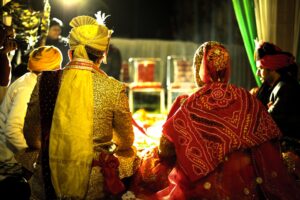
In the last decade a number of relevant digital content have come up opening a dialogue around marriages, familial bonds and most scandalously, weddings! Weddings, the gateway drug to eternal bliss, has been picked on, taken apart and thoroughly scrutinized through enterprising filmmakers on OTT platforms. This seemingly most harmless part of marriages found a booming mainstream critic in the drama series Made in Heaven. For the first time we had a mass product that explored a deeply problematic system that has been hidden in sparkly decorations and cultural fantasies for ages. The series questioned the authenticity of the very first day in a marriage and provoked one into thinking of the often-distorted basis on which the fairytale of marriages is constructed.
The almost parodying contemporary of the fictional Made in Heaven is the reality television series Indian Matchmaking. While the show has been subjected to extensive trolling and fairly so – it is still a grotesquely honest portrayal of the shamelessly casteist NRI community settled abroad being coached by the proudly sexist matchmaker herself. The hilarious abandon of the show could have made it an official comedy had it not been such a boomerang of reality.
It is interesting that the Kerala HC’s observation in September 2022 of the younger generation’s “culture of use and throw” came at a time when the current discourse is magnifying the institution and validity of marriage with such attention. The comment was made during a divorce appeal by a thirty-four years old man against his thirty-eight years old wife with whom he has three children. The man filed this appeal in order to pursue a relationship with another woman while accusing his wife of cruelty. In response to his plea the division bench responded that “mere quarrels or casual outbursts of emotion cannot be treated as cruelty.” Additionally, the bench also remarked that “the younger generation think that marriage is an evil that could be avoided to enjoy free life without any liabilities or obligations.”

To understand the court’s comments, let’s try and break down what marriage roughly entails. Marriage has multiple forms described for the major religions in India. While in Hinduism there exists recognition for the basis of marriage being mutual consent, parental approval, dowry, abduction and even rape; Islam has descriptions of unlawful marriage as well as temporary marriage. Indian marriages might be legalised by the government but continue to operate on religious and familial laws. Suffice to say, these delineations are not actually about marriages but about weddings, the circumstances that lead to a marriage. Inspecting the pretext which lead to the union of two people can be an important insight to learning how a marriage functions.
While the foundation may or may not have religious undertones, the practicality of Indian marriages is embedded in technology. The technological revolution ushered in a new era for citizens worldwide, however, digital laws have failed to catch up with the pace of development. Security or privacy has more or less been left up to individual supervision.

In an atmosphere of abundant opportunities and unending choices, it would be rather surprising if modern dwellers were not confused vagabonds when it comes to orthodox institutions. There are two sides to this though.
One, women’s financial independence. For the longest time marginalised communities have been suffering the indignity of unpaid or underpaid labour. While this problem still has a gruelling road to travel before true resolution comes to pass, issues like gender discrimination and wage gap are finally being addressed. Changes may not be too explicit yet but women have begun occupying spaces to voice their grievances – which is a significant first step from the absolute patriarchy friendly silence of yore.
This change is largely restricted to privileged, upper caste women at present due to the rate of percolation any change has to go through – but its clout is enough to upset the traditional laws of Indian marriages. Women, historically being parties who are either traded or simply given, stripped of autonomy, have started to assert their say and this is where we enter muddy waters.
The upliftment of one section of society demands synchronization from others. This knowledge gap thus present ripple effects in the form of increased divorces, lower familial attachment and general resentment. All of these were not threatening as long as one section was oppressed and had lower agency. Systemic exploitation rendered helplessness would be embellished as virtues like patience and devotion; whereas in really it was just the lack of an option. Arriving at an era where sacrifices have to go both ways, desire for partnership has to go both ways, childcare sensibilities have to go both ways thus present a challenge to not only an oppressing individual but to the entire foundation of marriage. Selfishness and the urge to “enjoy life” as the Kerala HC bench declares can perhaps be seen simply as the awareness to choose in a world opening up rapidly through digitization.
“Those who talk most about the blessings of marriage and the constancy of its vows are the very people who declare that if the chain were broken and the prisoners left free to choose, the whole social fabric would fly asunder. You cannot have the argument both ways. If the prisoner is happy, why lock him in? If he is not, why pretend that he is?”
Man and Superman, Act 3
Two, the purity of marriage as an institution. The court remarked that “marriage is not a mere ritual for licensing the sexual urge of the parties, and that there is sanctity attached to it.” This idea of purity, while it aligns beautifully with the systemic campaign, it also becomes an issue only in actions that breach the established code. How should one trace purity in a concept traditionally marked by maximum mutual convenience? Dowry deaths, the surge of demanding pre-nuptials, the hideousness in alimony wars – how do these manifestations of marriage arrive from a foundation of purity?
Going forward, the debate and chaos around marriages in India might find solace in revisiting the laws. Regardless of gender, the institution of marriage may be practically built for conserving the family unit but perseveres (or is trying to) due to its philosophical implications. The sociological ushering of the last decade in terms of gender sensitization, recognition and acceptance of the queer community and digital revolution, call for an immediate updation of the general value system with assistance from authority figures like the judiciary among others. Treating marriage as a process rather than a destination may help to not only give the institution a new life but also help restoring faith and respect for allied institutions of the nation.
“Unless the law of marriage were first made human, it could never become divine” – George Bernard Shaw.

